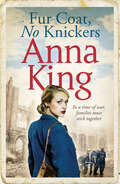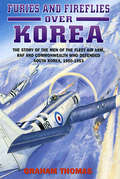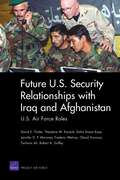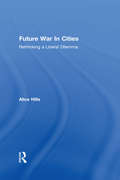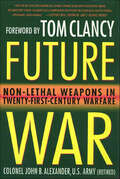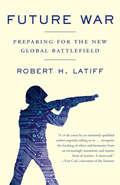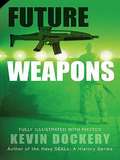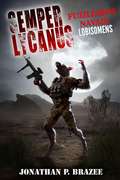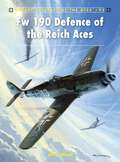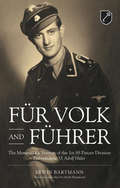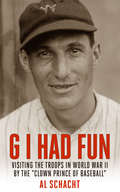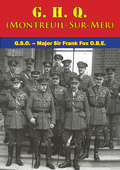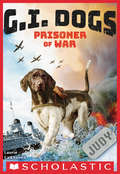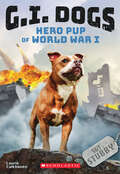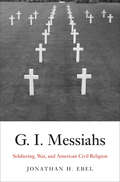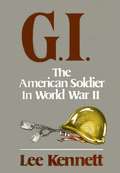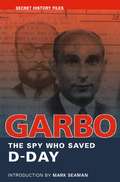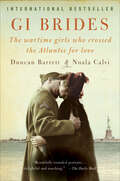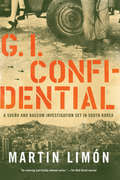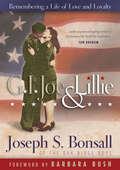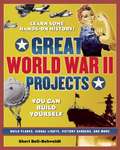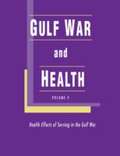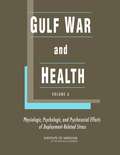- Table View
- List View
Fur Coat, No Knickers
by Anna KingA city torn apart by war. A family torn apart by tragedy. A classic World War II saga from the author of Palace of Tears. At the top of Lester Road in London&’s East End stands &“Paddy&’s Castle,&” the three-story, red-bricked Georgian house that is home to Grace Donnelly and her family. Life may be hard in the late 1930s, but it is nothing compared with what is about to follow. Grace&’s beloved fiancé Stanley decides to enlist in the fight against Nazi Germany. And as the sirens signal blitz after blitz of bombers, the family can only hide in the cellar and hope they will survive. But Grace has more than just the Germans to worry about. The good-looking Nobby Clark is keen to do more than just look out for his best friend&’s fiancée. And scheming barmaid Beryl Lovesett is determined to worm her way into the family home, seducing Grace&’s uncle with her fur coat, no knickers . . . &“A gripping wartime novel, with strong female characters . . . Full of courage, hope, and heartbreak.&” —Alina&’s Reading Corner
Furies and Fireflies over Korea: The Story of the Men of the Fleet Air Arm, RAF and Commonwealth Who Defended South Korea, 1950–1953
by Graham A. ThomasThe historian and author details the exploits of British and Australian pilots during the Korean War. With the outbreak of the Korean War, the UN Security Council called on its members to act and 16 nations did, with Britain sending aircraft carriers such as HMS Truimph, from which piston-engined Sea Fury fighters and Fairey Firefly fighter-bombers operated. This is the story of the British and Australian Fleet Air Arm pilots and their missions over hostile territory, missions carried out with distinction and honor.
Future Air Force Needs For Survivability
by National Research Council of the National AcademiesA key technical issue for future Air Force systems is to improve their ability to survive. Increased use of stealth technology is proposed by many to be the major element in efforts to enhance survivability for future systems. Others, however, suggest that the high cost and maintenance required of stealth technology make increased speed potentially more productive. To help address this issue, the Air Force asked the NRC to investigate combinations of speed and stealth that would provide U.S. aircraft with a high survival capability in the 2018 period, and to identify changes in R&D plans to enable such aircraft. This report presents a review of stealth technology development; a discussion of possible future missions and threats; an analysis of the technical feasibility for achieving various levels of stealth and different speeds by 2018 and of relevant near-term R&D needs and priorities; and observations about the utility of speed and stealth trade-offs against evolving threats.
Future U.S. Security Relationships with Iraq and Afghanistan
by Frederic Wehrey David E. Thaler Dalia Dassa Kaye Jennifer D. Moroney Theodore W. KarasikThe authors describe possible regional security structures and bilateral U.S. relationships with Iraq and Afghanistan. They recommend that the United States offer a wide range of security cooperation activities to compatible future governments in Kabul and Baghdad but should also plan to hedge against less-favorable contingencies. They emphasize that the U.S. Air Force should expect to remain heavily tasked for the foreseeable future.
Future War In Cities: Rethinking a Liberal Dilemma
by Alice HillsThis book is the first full-length study of a key security issue confronting the west in the twenty-first century, urban military operations - as currently being undertaken by US and UK forces in Iraq. It relates military operations in cities to the wider study of conflict and security in an era of urbanisation, expeditionary warfare and new power
Future War: Non-Lethal Weapons in Twenty-First-Century Warfare
by John B. AlexanderThe nature of warfare has changed! Like it or not, terrorism has established a firm foothold worldwide. Economics and environmental issues are inextricably entwined on a global basis and tied directly to national regional security. Although traditional threats remain, new, shadowy, and mercurial adversaries are emerging, and identifying and locating them is difficult. Future War, based on the hard-learned lessons of Bosnia, Haiti, Somalia, Panama, and many other trouble spots, provides part of the solution.Non-lethal weapons are a pragmatic application of force, not a peace movement. Ranging from old rubber bullets and tear gas to exotic advanced systems that can paralyze a country, they are essential for the preservation of peace and stability. Future War explains exactly how non-lethal electromagnetic and pulsed-power weapons, the laser and tazer, chemical systems, computer viruses, ultrasound and infrasound, and even biological entities will be used to stop enemies. These are the weapons of the future.
Future War: Preparing for the New Global Battlefield
by Robert H. LatiffAn urgent, prescient, and expert look at how future technology will change virtually every aspect of war as we know it and how we can respond to the serious national security challenges ahead. Future war is almost here: battles fought in cyberspace; biologically enhanced soldiers; autonomous systems that can process information and strike violently before a human being can blink. A leading expert on the place of technology in war and intelligence, Robert H. Latiff, now teaching at the University of Notre Dame, has spent a career in the military researching and developing new combat technologies, observing the cost of our unquestioning embrace of innovation. At its best, advanced technology acts faster than ever to save the lives of soldiers; at its worst, the deployment of insufficiently considered new technology can have devastating unintended or long-term consequences. The question of whether we can is followed, all too infrequently, by the question of whether we should. In Future War, Latiff maps out the changing ways of war and the weapons technologies we will use to fight them, seeking to describe the ramifications of those changes and what it will mean in the future to be a soldier. He also recognizes that the fortunes of a nation are inextricably linked with its national defense, and how its citizens understand the importance of when, how, and according to what rules we fight. What will war mean to the average American? Are our leaders sufficiently sensitized to the implications of the new ways of fighting? How are the attitudes of individuals and civilian institutions shaped by the wars we fight and the means we use to fight them? And, of key importance: How will soldiers themselves think about war and their roles within it? The evolving, complex world of conflict and technology demands that we pay more attention to the issues that will confront us, before it is too late to control them. Decrying what he describes as a "broken" relationship between the military and the public it serves, Latiff issues a bold wake-up call to military planners and weapons technologists, decision makers, and the nation as a whole as we prepare for a very different future.
Future Weapons
by Kevin DockeryOn the battlefield, a soldier's best friends are his gun and his gear-because his life depends on them. But what will it take to fight and survive on the battlefields of tomorrow? What will those combat arenas consist of, and where will they be? And what will our nation's fighting men and women carry with them into battle? This is a compendium of the weapons of war that may accompany our soldiers in the near and far future, as well as an insightful look at the soldier, sailor, and airman of today and tomorrow. All manner of military hardware is covered, as well as information about cutting-edge technology that will become standard in weapons to come, the possibility of robotic soldiers, vehicles, protective armor, and the prospects of fighting a war in both space and cyberspace.
Future of Battlespace Situational Awareness: A Workshop Summary
by Daniel TalmageFuture Battlespace Situational Awareness is the third workshop in an ongoing series of workshops conducted by the National Research Council's Committee for Science and Technology Challenges to U.S. National Security Interests. The first two workshops looked at individual technologies related to "big" data and future antennas and provided context for the topic addressed in the third workshop—the planning of a future warfare scenario. The objectives for the third workshop were to review technologies that enable battlespace situational awareness 10-20 years into the future for red and blue forces; and emphasize the capabilities within air, land, sea, space, and cyberspace.
Fuzileiros Navais Lobisomens
by Jonathan P. BrazeeUm grupo de fuzileiros navais lobisomens que lutam pela liberdade, enfrentando inimigos perigosos.
Fw 190 Defence of the Reich Aces
by John WealThis title is the natural conclusion to the collection of titles chronicling the exploits of the fighter pilots of the German Luftwaffe of World War 2 that has been part of - and contributed in some small measure to the success of - Osprey's long running Aircraft of the Aces series. Since the first appearance of Aircraft of the Aces 2 back in 1994, a further ten titles by various authors have been published on German fighters and their pilots. Together, these provide a comprehensive and unique overview of all the famous names (together with some lesser-known ones) who flew fighters 'for the other side' during the war . . . all, that is, except for one final category - those who were operationally on the Focke-Wulf Fw 190 in the defense of their own homeland during the later stages of the conflict from mid 1942 to May 1945. There has not been a work in either English or German - to the writer's knowledge - that deals specifically with this particular subject. Combining a selection of previously unpublished black and white photographs and color profiles, it admirably fulfills two roles - standing on its own, it provides something entirely new for the aviation historian and/or modeler, while as part of Osprey's Aircraft of the Aces collection, it closes the one remaining gap in the coverage of the Luftwaffe's World War 2 fighter pilots and their frontline operations.
Für Volk and Führer: The Memoir of a Veteran of the 1st SS Panzer Division Leibstandarte SS Adolf Hitler
by Erwin Bartmann Derik HammondOne German soldier’s experience in the deadly crucible of World War II combat. Like many Germans, Berlin schoolboy Erwin Bartmann fell under the spell of the Zeitgeist cultivated by the Nazis. Convinced he was growing up in the best country in the world, he dreamt of joining the Leibstandarte, Hitler’s elite Waffen SS unit. Erwin fulfilled his dream on May Day 1941, when he walked into the Lichterfelde barracks in Berlin as a raw recruit. On arrival at the Eastern Front in late summer 1941, Erwin was assigned to a frontline communications squad. When the end of the Reich became inevitable, Erwin was forced to choose between a struggle for personal survival and the fulfillment of his SS oath of “loyalty unto death.” From the war on the southern sector of the Eastern Front to a bomb-shattered Berlin populated largely by old men and demoralized women, this candid eyewitness account offers a unique and sometimes surprising perspective on the life of a young Leibstandarte SS Adolf Hitler volunteer. “A valuable memoir, providing both a good account of the changing attitudes of the author, both towards the Nazi regime and the chances of final victory.” —History of War
G I Had Fun
by Al SchachtG I Had Fun, first published in 1945, is the inspiring World War Two account by major-league baseball player and coach Al Schacht. Schacht, known as the “Clown Prince of Baseball” for his hilarious antics, entertained thousands of troops in North Africa, Sicily, and the South Pacific on several USO tours. As the book’s jacket states, G I Had Fun is written “not as a comic trying to put over a gag, but as a humble human being who has been deeply moved by what he has seen. There is a depth of sincerity and feeling, as well as humor, that is wholly honest.” To the GI far from home, his efforts were much enjoyed and appreciated, and an important boost to the men’s morale. Schacht would later open a popular restaurant in New York City and sometimes perform his comedy routines for his guests. He passed away in 1984.
G. H. Q. (Montreuil-Sur-Mer) [Illustrated Edition]
by G.S.O. – Major Sir Frank Fox O.B.E.Includes the First World War Illustrations Pack - 73 battle plans and diagrams and 198 photosAccount of the work at G.H.Q. by an officer (Australian Sir Frank Fox) who served there attached to the Quartermaster-General's Branch. "His account of the conditions in which a junior administrative staff officer lived & worked is valuable, especially as there are few records of this sort." - Falls
G.I. Dogs: Judy, Prisoner of War (G. I. Dogs Ser. #1)
by Laurie CalkhovenMeet Judy: an English Pointer and member of her Majesty's Royal Navy who served bravely alongside her crew during World War II. When her ship was sunk by the enemy, Judy became the only canine prisoner of war of the Japanese. Join Judy on her incredible journey from puppy to soldier to POW as she narrates her story of survival and heroism. This "dog's-eye view" takes readers into the heart of the naval action of WWII and will leave you cheering for Judy and her human companions as they overcome countless obstacles and prove time and again why a dog really is man's best friend.
G.I. Dogs: Sergeant Stubby, Hero Pup of World War I (G.I. Dogs #2)
by Laurie CalkhovenGo behind enemy lines through the eyes of famous four-legged heroes in history's biggest conflicts. In G.I. Dogs #2, you'll meet Sergeant Stubby, the most decorated canine soldier of World War I!Meet Stubby: a stray pup who was taken in by a group of American soldiers-in-training and soon found himself whisked off to the frontlines of World War I as the official mascot of the 102nd Infantry Regiment! Stubby served bravely by his soldiers' sides for 18 months and became a hero when he saved his regiment from a surprise gas attack, and again when he singlehandedly caught an enemy German soldier in No Man's Land.Join Stubby on his incredible journey from puppy to soldier to high-ranking sergeant as he narrates his story of heroism. This "dog's-eye view" takes readers into the heart of the action of WWI and will leave you cheering for Stubby and his human companions as they overcome countless obstacles and prove time and again why a dog really is man's best friend.
G.I. Messiahs
by Jonathan H. EbelJonathan Ebel has long been interested in how religion helps individuals and communities render meaningful the traumatic experiences of violence and war. In this new work, he examines cases from the Great War to the present day and argues that our notions of what it means to be an American soldier are not just strongly religious, but strongly Christian. Drawing on a vast array of sources, he further reveals the effects of soldier veneration on the men and women so often cast as heroes. Imagined as the embodiments of American ideals, described as redeemers of the nation, adored as the ones willing to suffer and die that we, the nation, may live-soldiers have often lived in subtle but significant tension with civil religious expectations of them. With chapters on prominent soldiers past and present, Ebel recovers and re-narrates the stories of the common American men and women that live and die at both the center and edges of public consciousness. "
G.I.: The American Soldier in World War II
by Lee KennettLee Kennett provides a vivid portrait of the American soldier, or G.I., in World War II, from his registration in the draft, training in boot camp, combat in Europe and the Pacific, and to his final role as conqueror and occupier. It is all here: the "greetings" from Uncle Sam; endless lines in induction centers across the country; the unfamiliar and demanding world of the training camp, with its concomitant jokes, pranks, traditions, and taboos; and the comparative largess with which the Army was outfitted and supplied. Here we witness the G.I. facing combat: the courage, the heroism, the fear, and perhaps above all, the camaraderie--the bonds of those who survived the tragic sense of loss when a comrade died. Finally, when the war was over, the G.I.'s frequently experienced clumsy, hilarious, and explosive interactions with their civilian allies and with the former enemies whose countries they now occupied.
GARBO: The Spy Who Saved D-Day
by Mark Seaman National ArchivesJuan Pujol, a young Spanish antifascist, became agent GARBO, a master of deception and intrigue. His story contains all the hallmarks of classic spy adventure—enciphered messages, secret inks, items concealed in cakes—culminating in one of the greatest strategic deceptions in history. Through a ring of invented subagents, GARBO and his MI5 controllers succeeded in convincing the Germans that the DDay landings were only a diversionary tactic, thus safeguarding the Allied landings and hastening the end of the war in Europe. Secret History Files is an exciting series from The National Archives that puts covert history in readers’ hands. Dossiers previously classified as "Top Secret" are now available, with an explanatory introduction and background analysis by expert historians. Publisher’s Note: This publication brings you in full the ’Summary of the Garbo Case 1941—1945’ by Tomás Harris. All document references are to the original files, which may be consulted under supervision at the National Archives, Kew. Our intention is to reproduce the material as faithfully as possible without compromising the integrity of the original. This means that the occasional inconsistency or typing error survives from Harris’s text. The symbol […] is used where material from the original document has been retained under section 3(4) of the Public Records Act 1958.
GI Brides: The Wartime Girls Who Crossed The Atlantic For Love (GI Brides #1)
by Nuala Calvi Duncan BarrettThis “delightful and touching” international bestseller tells the true stories of four British women who married American soldiers after WWII (Daily Mail, UK).American soldiers stationed in the UK came away winning more than just a war, they also won the hearts of young women across Britain. At the end of World War II, more than 70,000 GI brides followed the men they’d married—men they barely knew—to begin a new life in the United States. This volume vividly recounts the stories of four such women as they made America their home.In GI Brides, readers will meet Sylvia Bradley, a loyal, bright-eyed optimist; Rae Brewer, a resourceful, quick-witted tomboy; Margaret Boyle, an English beauty who faced down every challenge; and Gwendolyn Rowe, a brave woman ahead of her time. Though all made the bold choice to leave family and the world they knew, the journey each experienced was unique—ranging from romantic to heartbreaking.
GI Confidential (A Sergeants Sueño and Bascom Novel #14)
by Martin LimonUS Army CID Agents George Sueño and Ernie Bascom become entangled with a pushy tabloid reporter as they investigate a series of violent bank robberies throughout South Korea. South Korea, 1970s: A rash of armed robberies at local Korean banks doesn’t concern the American military—until a fatality occurs, and proof surfaces that US soldiers are behind the crimes. The case has been assigned to CID Agents Jake Burrows and Felix Slabem, but they certainly won’t do anything that might make 8th United States Army look bad. So Sergeants George Sueño and Ernie Bascom have decided to step in and investigate the robberies—and murder—themselves. George and Ernie have their own problems to worry about, namely Katie Byrd Worthington, a pesky reporter for the Overseas Observer—an unsanctioned English-language tabloid that has found strong roots in South Korea. Katie has published a story that implicates Army higher-ups in both sex trafficking and treason, and the pressure is on for the CID to disprove her claims. But what if they aren’t false? As George and Ernie dig deeper into the case, they find themselves the targets of a very unflattering publicity campaign, but perhaps also something much more dangerous.
GI Joe & Lillie: Remembering a Life of Love and Loyalty
by Joseph S. BonsallIn the early morning hours of June 6, tens of thousands of boys from the shores of Maine, the rivers of Mississippi, and the lakes of Minnesota were taking a boat ride that would go down in history. With the ocean spray in their faces and hearts practically beating out of their chests, American G.I.s peers through the mist and saw the beaches of France. The Allied invasion of Hitlers Europe was on! A skinny kid from Philly checked his rifle for the umpteenth time and swallowed hard. A strip of beach codenamed Utah lay just ahead.... The 1944 D-Day landings preserved freedom all over the world and affected countless individual lives including G.I. Joe and his wife, Lillie. After the war, G.I. Joe and Lillie settled into a life that included two children. Old wounds, though, never quite let G.I. Joe leave France. Nightmares and crippling injuries left him with only one true friend, but she was all he'd ever need. Lillie embarked on a decades-long love affair, from the moment she saw that skinny boy from Philly in an army hospital. Five days of courtship and 55 years of marriage strengthened by faith saw to that. Lillie prayed daily for her husband and children in the difficult years ahead. Together, they made it all the way home. In Lillie's America, it was sacrifice that preserved cherished freedoms, and loyalty kept families united and strong. Lillie's steadfast faith and heartfelt devotion is a lesson for our time. This story of patriotism, bravery abroad and at home, and most of all, deep commitment, sets in a gold frame the very essence of America. The story of G.I. Joe and Lillie helps us all remember that true love never, ever dies.
GREAT WORLD WAR II PROJECTS
by Sheri Bell-RehwoldtFrom spy maps and victory banners to spotter planes and ration cakes, Great World War II Projects You Can Build Yourself brings one of the most defining periods of American and world history to life through hands-on building projects and activities. Detailed step-by-step instructions for creating each project combine with historical facts and anecdotes, biographies, and trivia about the real-life models. Together they give kids a first-hand look at daily life at home and on the front lines during America's war years.
GULF WAR and HEALTH: HEALTH EFFECTS OF SERVING IN THE GULF WAR
by Institute of Medicine of the National AcademiesIn 1998, in response to the growing concerns that many returning Gulf War veterans began reporting numerous health problems that they believed to be associated with their service in the Persian Gulf, Congress passed two laws which directed the Secretary of Veterans Affairs to enter into a contract with the National Academy of Sciences. They were tasked to review and evaluate the scientific and medical literature regarding associations between illness and exposure to toxic agents, environmental or wartime hazards, and preventive medicines or vaccines associated with Gulf War service. In addition, the Institute of Medicine of the National Academy of Sciences provided conclusions to these studies that were considered when making decisions about compensation to veterans. Gulf War and Health Volume 4: Health Effects of Serving in the Gulf War summarizes in one place the current status of health effects in veterans deployed to the Persian Gulf irrespective of exposure information. This book reviews, evaluates, and summarizes both peer-reviewed scientific and medical literature addressing the health status of Gulf War veterans.
GULF WAR and HEALTH: VOLUME 6
by Institute of Medicine of the National AcademiesThe sixth in a series of congressionally mandated reports on Gulf War veterans' health, this volume evaluates the health effects associated with stress. Since the launch of Operation Desert Storm in 1991, there has been growing concern about the physical and psychological health of Gulf War and other veterans. In the late 1990s, Congress responded by asking the National Academy of Sciences (NAS) to review and evaluate the scientific and medical literature regarding associations between illness and exposure to toxic agents, environmental or wartime hazards, and preventive medicines or vaccines in members of the armed forces who were exposed to such agents. Deployment to a war zone has a profound impact on the lives of troops and on their family members. There are a plethora of stressors associated with deployment, including constant vigilance against unexpected attack, difficulty distinguishing enemy combatants from civilians, concerns about survival, caring for the badly injured, and witnessing the death of a person. Less traumatic but more pervasive stressors include anxiety about home life, such as loss of a job and income, impacts on relationships, and absence from family. The focus of this report, by the Institute of Medicine (IOM) Committee on Gulf War and Health: Physiologic, and Psychosocial Effects of Deployment-Related Stress, is the long-term effects of deployment-related stress. Gulf War and Health: Volume 6. Physiologic, and Psychosocial Effects of Development Related Stress evaluates the scientific literature regarding association between deployment-related stressors and health effects, and provides meaningful recommendations to remedy this problem.
